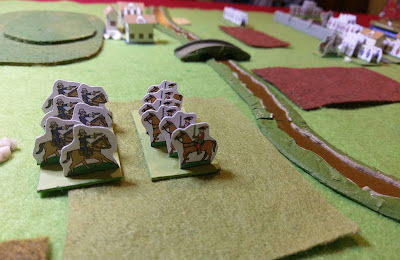This evening I played through a refight of the Battle of Whalley using the Portable Wargame. I used the same troop classifications as the previous game, but with a few changes to the setup and the rules.
Firstly I shifted the map up one row so that the Parliamentarian right flank wasn't so exposed. Secondly I started the two Royalist units facing the wall with a hit each. Finally I made two changes to the actual rules. The first one was that I used the Average line on the hit results for all troop; 1-3 the unit takes the hit, 4-6 they can retreat or take the hit. I'll discuss this below. Secondly I reflected quality by varying the number of hits a unit could take; Poor units took one less and Elite one more. This was factored into the Exhaustion Levels as well. Finally I added a small change to the initiative roll; if the score is a double, then the side which eventually gains initiative was allowed to recover one hit on a unit of their choice. I rather liked the idea of a double having an effect. Again I'll discuss this below.
So this was the setup. The fields were just for show; the key terrain consists of the villages, hills river, bridge, ford and wall.
The Royalists got a rally on the first turn, removing the initial hit from their rather poor dragoons. After a brief exchange of fire at the wall, the Royalist troops fell back across the stream to await reinforcements.
On the other flank the horse of both sides met at the stream.
The Royalists pushed forward boldly, since their troops had the edge in terms of quality.
They were forced back, though. Both sides lost a unit, but the Parliamentarian horse was better supported. Parliament pushed forward against the retreating Royalist foot and horse.
The Royalists best foot unit was badly mauled in the attack, and sought shelter in a village on their side of the stream. But the rest of the Royalist army stabilised their position, and with the pressure mounting, the Parliamentarians fell back to the safety of the walls. The Royalists followed up.
The clubmen attacked an elite Parliamentarian foot regiment in the flank. This was a bold move that rapidly came unstuck, as the regiment simply turned and shot the hapless peasants down. next time they'll learn to attack with support.
Despite their lack of quality, the Parliamentarian horse drove forward with panache, and eventually routed the other unit of Royalist horse. This pushed the Royalists over the Exhaustion Point, stopping their attack.
The Royalists started to fall back to their side of the stream, but Parliament pressed them hard.
The Royalist dragoons were routed at the ford (far distance in this picture) and at that point I decided that the day belonged to Parliament.
This was a fun game, with a real to and fro to the action; the Royalists were pushed back at first, rallied and went on the offensive, but were then driven back again. Their best foot unit was savagely mauled early on, and they never got a chance to recover it, whilst their horse were totally outfought.
But let's discuss the changes to the rules. Firstly the change to the way units take hits. The current method does work. Poor units are more likely to take hits whilst better units have the option to avoid them by falling back. But I found that this method didn't really feel right when one side was defending a position. In this case a retreat really isn't an option, so the effect of quality is almost irrelevant. One option was to add results which forced a retreat, making it more likely for Poor units to receive it. But I couldn't quite work out how to build it into the table in a way that made sense. But the rules themselves include an option for changing the number of hits a unit could take. Combined with the retreat rules this makes Elite units rather too good; an extra hit and less chance of taking hits in the first place. But with all units getting stand and take a hit or retreat equally, then the extra hit a unit was allowed makes a difference. It didn't seem to adversely affect this game, and I'll try it again in some more I think.
The second change simply makes use of doubles for the initiative roll. I should say that I don't like wasted rolls, where you simply roll again until you get a result.. One option was to automatically give the initiative to whichever side didn't have it in the previous round. But I opted for the rallying off of a single hit instead, as it seems more dramatic. One downside is that it doesn't connect too well with the Exhaustion Point rules, as a side opposing one which has reached its Exhaustion Point, and which can't take offensive action, could simply pull back and recover all hits before going in again. Maybe playing games to a turn limit would mitigate this. I think I'll try that in future games. A final thought on the rallying is to go back to the original system where a side reaches its Exhaustion Point based simply on hits taken, rather than units lost. With rallying this allows a side to possibly recover from exhaustion, but there's still the danger that a good run of combats along a line of battle could break a side very early on in a game. This was, in fact, the reason I shifted to basing things on lost units.
Anyway, plenty of ideas to explore, which means more games I guess.










No comments:
Post a Comment